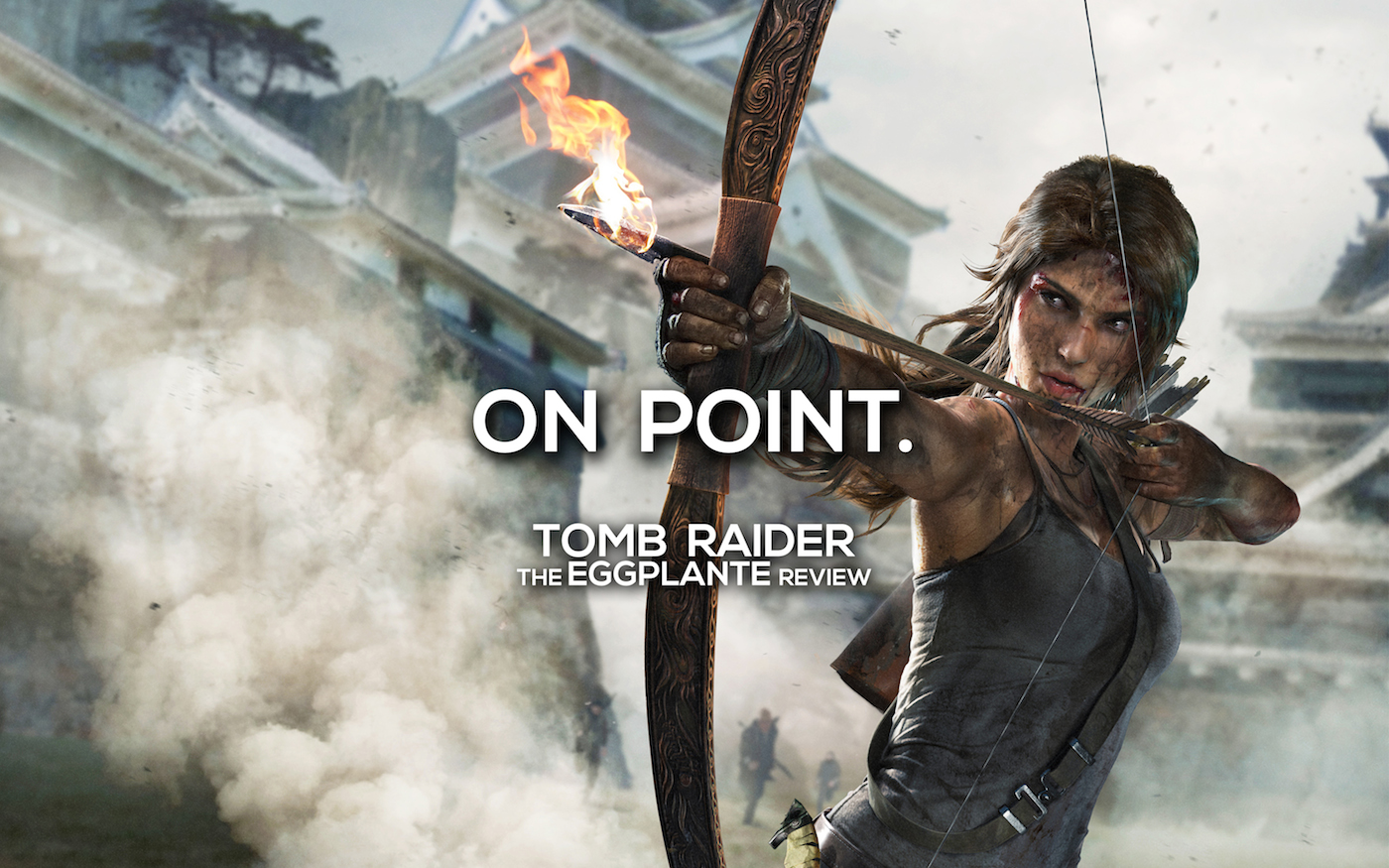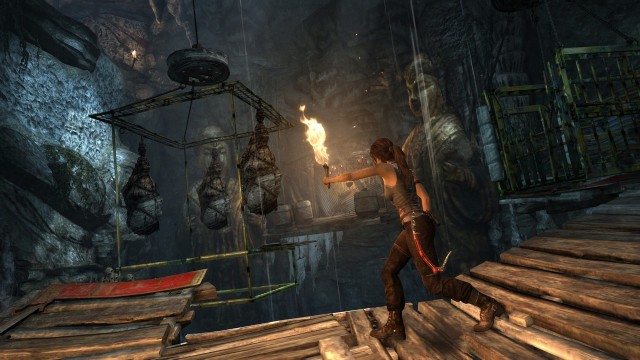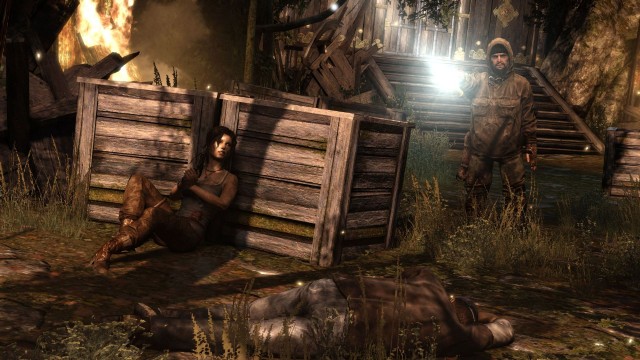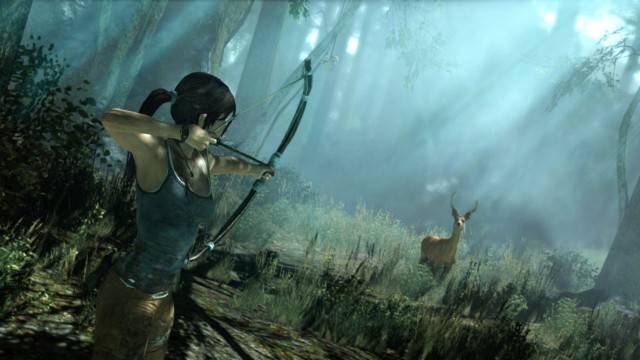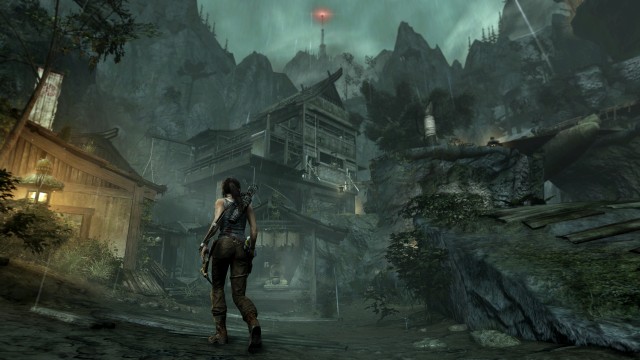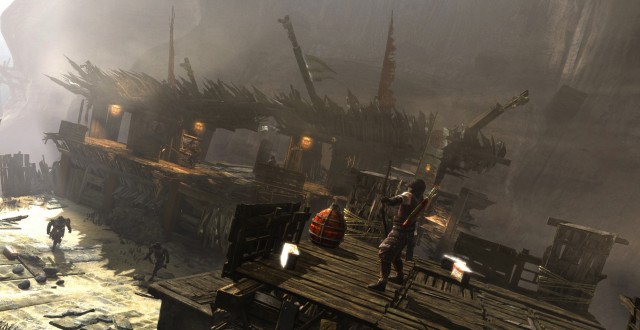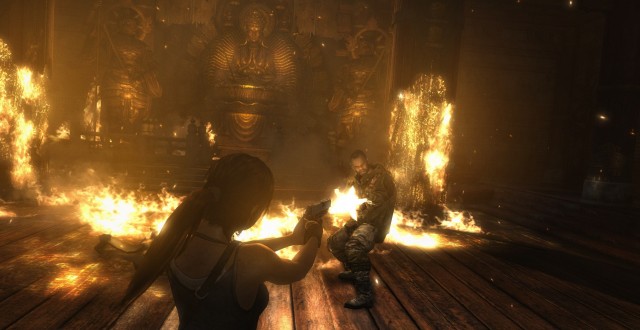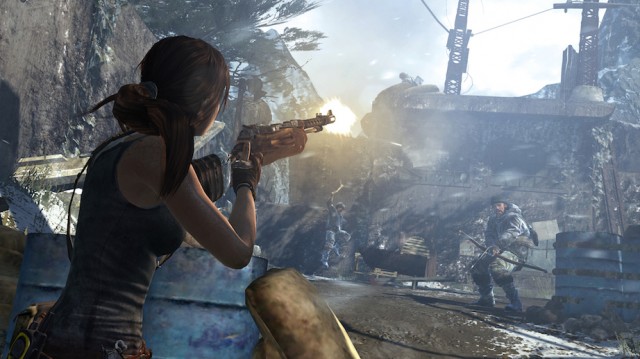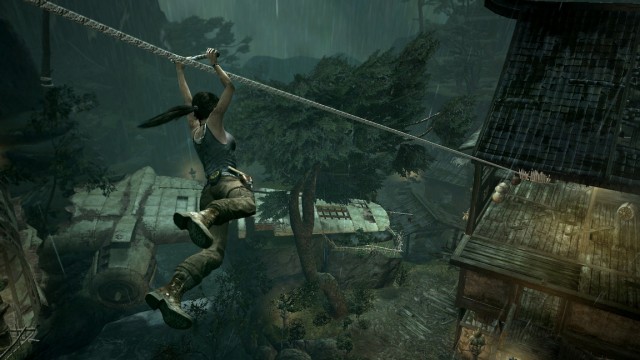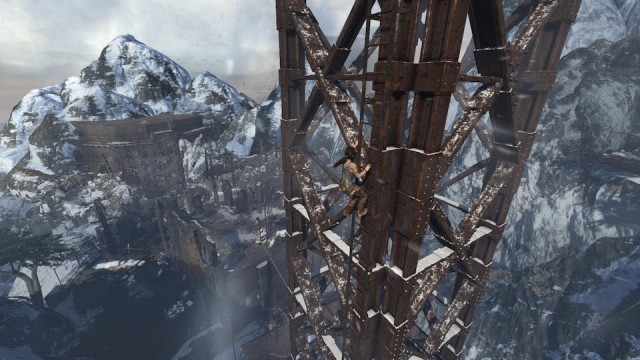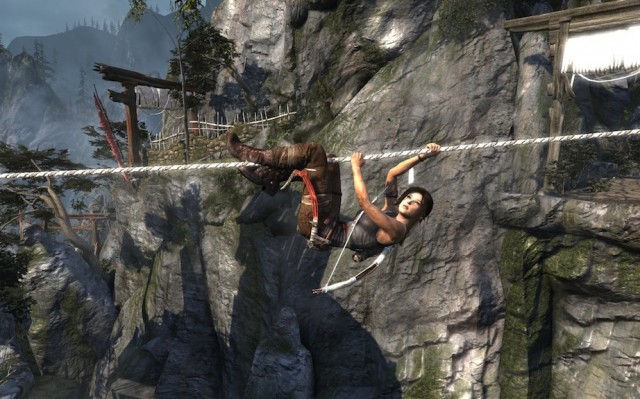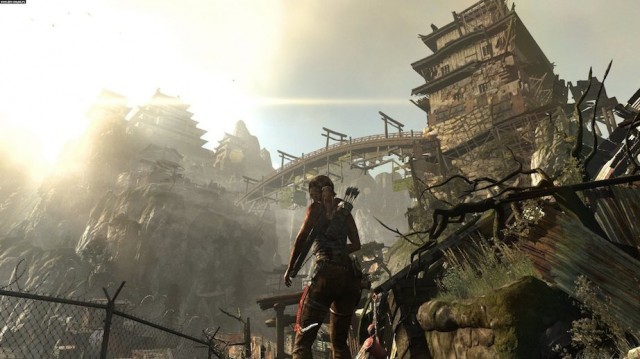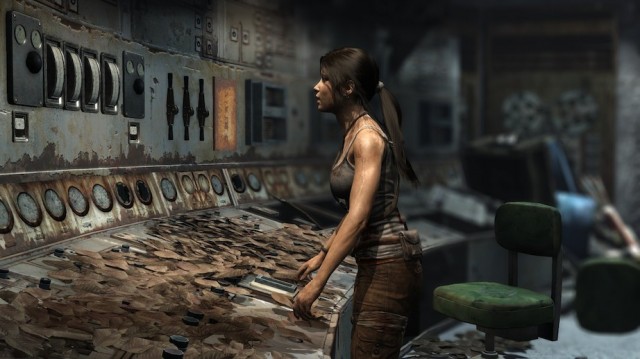Writing this review is a total labour of love. In what has become our longest review to date, Tomb Raider was an absolute joy to play. It is not without its missteps, nor is it a perfect game (we’re not sure we’ve ever played one of those), but it is so excellently woven together, we couldn’t help but feel transported into its world.
We’ll start with the thing that this review is not. It is not an article to read if you don’t want to be spoiled. We won’t throw the whole story at you, but there will be a few spoilers if you haven’t played through the game. With that said, enter Tomb Raider:
It’s hard to believe that a game we first saw at E3 a few years ago has reached its conclusion. When we first saw Crystal Dynamics’ reboot of the franchise, we were blown away. The game also became our surprise hit of the show and our favourite game of E3 2011.
Firing up the game, the menu screen took us right back to that E3 presentation. Of course, this isn’t the focus of the game, but it is our first impression. It’s broken, gritty, and stained, much like Lara and the island she has her adventure on.
The game begins with a shipwreck almost immediately and we see Lara separated from the crew of the Endurance, a research vessel careening through the seas near Yamatai, an ancient Japanes kingdom ruled by Himiko, the Sun Queen. This is all based on real history, as entries in the Tomb Raider franchise often are. The shipwreck on the island happens too quickly, as we don’t really get a chance to learn much about the other characters on board, nor are we offered time to grow attached to them, but Crystal Dynamics has other tricks up its sleeve to tell the backstory of its game.
Gameplay starts almost immediately after that first cutscene, as Lara hangs upside down in an eerie tomb. She’s been captured, and the only way out is to light herself on fire and fall to the ground, where a piece of rebar pierces her torso. This is just setting the stage for the slightest of injuries she is about to endure.
As you escape, you’re attacked by who we can only assume to be one of the people who put you there, and the first of many quick-time events in the game occurs. There’s been a lot of talk of these events ruining the gameplay in some ways, and while it’s true that they happen often throughout the experience, we actually think it makes the gameplay better.
Quick-time events are often excuses to not come up with unique and original gameplay. Crystal Dynamics has designed a stellar game from its use of camera angles to lighting and shadows, and even the use of brutal death animations that don’t hold back. The quick-time events in the game work for a few reasons. First, they’re never randomly set and rely on your timing rather than reflexes, or worse, attempting to guess the right button. Second, they utilize the same button presses as the action buttons in the game, so you know exactly what is coming when the buttons appear on-screen. And while there are quite a few, the gameplay, for the most part, doesn’t rely on them as a means to move your character along.
Controls have been mapped so well in Tomb Raider that we were instinctively pushing buttons even before they’d pop up on screen to do so. If Lara struggled to grab a ledge, we’d be tapping the X button (the square button on the PlayStation 3; we played on Xbox 360) well before we were prompted to. It spoke volumes for how well the game was designed with a controller in mind, and while we can’t speak for the PC version of the game, we have a hard time believing it controls better than this.
Within the first few minutes of the game, we were treated to some basic puzzle solving, and it did exactly what it was supposed to: whet our appetite for more. The rest of the game does exactly that, and while it doesn’t ever deliver massive puzzles like you’d expect from a Tomb Raider game, there are some head-scratchers.
There are puzzles weaved into the narrative here and there, but nothing like you’ve played in any previous Croft game. Uncharted also has more puzzle solving than this, though that isn’t saying much.
On the topic of Uncharted, many people forget that Nathan Drake’s adventures actually began thanks to Lara Croft. The Uncharted series was heavily inspired by Tomb Raider, and while not a copy in any sense of the word, Tomb Raider pays some nice homages right back to Drake and his team.
Climbing in Tomb Raider is very reminiscent of Uncharted as everything is very rickety and falls apart easily. Ledges are marked for the gamer in a less than realistic way, but it serves a function that we can’t fault the development team for.
One thing we must harp on is the combat system. Far and away better than the combat system in Uncharted, Tomb Raider serves up some of the most satisfying kills in any video games. More satisfying than sawing someone in half with a Gears lancer, even. The ways Lara finishes off some of these baddies is insane and stunning to watch. The gruesomeness extends to the arrow that pierces a deer’s skull when she hunts or the climbing axe that tears a pair of ribs from an enemy’s torso. We’ll say it again: Crystal Dynamics didn’t pull a single punch.
Throughout Tomb Raider, there are some really stunning set pieces. The game feels composed of them at certain points, even. A plane, gutted and ripped apart, lays nose down married to a cliff, looks like it has been placed there on purpose. It messes with your head in a way that makes you second guess what you’re seeing.
Of course, the graphics in the game are up to par of everything else we’ve spoken of thus far. There are so many little details that Crystal Dynamics got right, this is easily one of the best looking games on any platform to date. The inflection in Lara’s walk and the slight murmurs under her breath are very indicative of a terrified woman, and getting that human condition right is not something we’ve seen before.
Lara’s skin is even its own dynamic map. As she gets involved in fist fights and gun battles, blood stains her skin and her clothes, and the spatters run down her face and body in different ways. As the game progresses, her clothes wear out to the point that the entire back of her tank top is almost entirely gone and the front begins to fray.
Lighting effects follow suit, as the illumination of Lara’s world can come from so many different sources. The torch she carries is dynamic enough to change under certain circumstances, such as being placed near the ceiling where the fire spreads out. The light from her fire arrows carries ever so slightly through the air, and a thin vein of smoke follows it. The light cast from lanterns and fire pits throughout Lara’s adventure reflects off nearby objects with realism and beauty.
There are some bizarre graphical glitches here and there, such as the remnants of a gun shot in a window that has already been destroyed. But these things happen so rarely and are so easy to miss that they hardly detract from the experience.
Perhaps the only unrealistic thing in the game is how Lara jumps. Never have we seen anyone make such God-like leaps from a standing position. It seems as if there were a few missing sessions of motion capture here. Lara manages to make such exaggerated and far-reaching jumps, whether horizontally or vertically, that it pulled us out of the experience. She also has the incredible ability to fall what we can only assume is about thirty feet without nary a scratch, assuming she rolls out of it.
There’s no HUD in Tomb Raider, leaving the player to see Lara, her world, and little else. There are small flashes of information on screen when you need them, but they go away moments later. It keeps the experience clean and clear and doesn’t clutter up what is otherwise a very movie-like experience.
Camera angles are one of the ways Crystal Dynamics delivers this very cinematic experience. Camera angles are entirely controller by the user, but in some key moments, such as when Lara wedges her body through a crevice in a rock wall, or barely keeps her head above water in an underground cave, the camera gets up close and personal as if there was someone capturing each of her moves from right behind her. It’s beautiful and keeps the pace elevated. Going through these moments, we couldn’t help but feel that there was something big about to happen on the other side. Whether there was or not, the anticipation kept us excited through the whole thing.
Tomb Raider isn’t a very bright game in its first half, nor should it be given its themes, but it does have a sort of colour quality we haven’t seen much in other games. This is a game that takes itself remarkably seriously, but it isn’t afraid of outdoor settings with bright explosions, or even sandy beaches. Though, those beaches do happen to be littered with mines and dead bodies.
Cutscenes are matched to gameplay almost perfectly. There’s no graphical difference between the two, and you will seldom be able to tell whether what you’re seeing is playable without flicking an analog stick. Load times are also a huge treat here as they’re virtually nonexistent. Often in games as large as Tomb Raider, load times become a major sticking point, but Crystal Dynamics must have hidden a lot of these screens behind large chunks of cinematics, because the game has some of the best load times we’ve ever seen. The game starts, respawns are quick, and the loading that bookends each set piece isn’t long enough to mention.
One of our favourite elements in any game is audio. Often overlooked, we take game audio to heart and find it to be one of the most important parts of a truly well-crafted experience. Not only does audio guide the way in some games, but it can make you feel ways you might not have thought you could by a video game.
In short, play Tomb Raider on loud. It sounds nothing short of gorgeous. Surround sound is key here, but if all you’ve got is a pair of stereo speakers or headphones, crank them up and enjoy. The full symphony orchestra and impeccable voice acting makes this game so realistic and powerful, we’re really shocked it’s not a movie. Equally, if not more telling, are the places in the narrative without any audio whatsoever. The silence is palpable and when the music reaches its full crescendo, a haunting dynamic really creeps into you and takes hold.
Dialog and voice acting in the game are flawlessly recorded, and if it weren’t for what was happening on-screen, we’d close our eyes and imagine the characters were speaking right next to us. Yes, it’s that good.
Lara does make some odd exclamations at some points during the game, but perhaps her character is to vocalize just how close that wolf attack was, even though no one is around to hear it. We kid, of course, but it was probably the only out of place audio in the entire game.
Tomb Raider offers plays the slightest hint of choice at one moment and abandons the theory altogether for the rest of the game. At one moment, in a single hallway, a man is lying on the ground, begging for his life. This man has recently tried to kill you, and while he has no energy now, you have the choice to kill or spare him. We whipped out our shotgun and planted a spray in his face, to which Lara muttered, “go to hell,” and it was intensely satisfying. Sadly, the game doesn’t go beyond this in offering any sort of real choice, but perhaps that is something for the next game in the series to do.
Traversing the mountains and beaches of Yamatai, you don’t come across nearly as many relics and artifacts as you might have in previous games in the series. Rather than every other element being a piece to discover or a puzzle to solve, the actual tomb raiding of Tomb Raider is kept to a minimum. Not everything is worth exploring, and Crystal Dynamics isn’t afraid to keep those moments in the background of their narrative. Sometimes, a dark cave leading to somewhere mysterious and unknown is just a dark cave.
Along your journey, there are hidden tombs (though they are called out by the game whenever you’re nearby, so perhaps they’re not so hidden) which house more traditional Tomb Raider puzzles. They rarely take more than ten minutes to solve, and there are no enemies in any of them, but they’re satisfying on an intellectual level that the rest of the game isn’t, and it’s a real breath of fresh air, despite the fact that the tombs are underground and devoid of any light most of the time.
With that said, the team has made some very unique and varied gameplay. An incredibly well-paced game, Tomb Raider doesn’t follow the same tropes of adventure games. Sure, there are periods of clearing out an area of bad guys before moving on to a small puzzle and doing it all again, but thankfully, the adventuring that goes on between these moments varies greatly. And they’re all crazy, intense moments: rafting down a white water river without the raft, running along rooftops of a burning building (or six), or falling out of a plane and parachuting through the tips of hundred-foot tall pine trees. And these all happen before the halfway point of the game.
Thankfully, you learn skills throughout the game that you keep through to end, and it makes you feel like a smarter player. When you first get the bow rope, you pull down a support beam holding up a pair of gunmen. Later in the game, you can use this rope to pull crates to you, create zip lines, and even to pull crushed rock that has fallen in front of a cave entrance.
There’s an upgrade system that Lara uses throughout the game that takes us out of the experience a bit. As you loot bodies and find crates of materials scattered around the island, you can use them to upgrade your weapons. But it doesn’t make any sense that a girl who is this frightened and terrified to be in the position she is in has the ability to whip together a longer magazine for her pistol, or create a counter balance for her bow and arrow. This thing isn’t entirely unbelievable, but we do wish that Crystal Dynamics had eschewed the gamey elements that can bog down an otherwise clean and pure experience like Tomb Raider.
Then there are things that Crystal Dynamics nails perfectly. The cover system in the game is one of the best, if not the best we’ve seen. There are no real cover points, nor is there a button that puts you into or takes you from it. Rather, the game knows that, in the middle of a firefight, if you’re next to a wall, you should probably crouch and hide. When the enemies are gone, the cover system disappears, and you’re free to do what you like. The cover system never got in our way during a gunfight, either, as there was no heavy magnetic system holding Lara to the side of an overturned barrel. It all seemed to work seamlessly well, and a lot of thought has clearly been put into its design.
Ending these battles, it is actually fun looting the baddies for their stuff. Ammo runs out quickly in the game, but there’s always a way to find more. It never feels tacked on to begin looting people, and you can do it as you run past them for the most part, so kudos for making it a necessary but more than bearable part of the game.
There’s very little hand-holding in Tomb Raider, nor should there be. Lara is off on this adventure of survival, and there is seldom anyone to help her, so we’re left to fend for ourselves alongside her.
Tomb Raider took us on some wild rides. In the end, we couldn’t help but feel like the game had taken us in some redundant circles. There was quite a bit of regrouping and then being set off to fend for yourself again, which made no sense in the situations we were thrown into. While well-paced with new game mechanics being introduced right through to the end, we couldn’t help but feel like the game didn’t need to keep going and going. At one point, about six hours in, we thought we’d approach the climax of the game, but another traumatic event happens, and you’re right back in the thick of things again.
It’s almost comical how much happens to Lara, really. Her boat crashes, she’s hung up to die, is thrown down a river, falls out of a plane barely escaping with her parachute, navigates the treetops in a parachute that breaks, falls to the ground, gets picked up by a helicopter that crashes to the ground, escapes a village as its buildings are burning to the ground, and falls through no fewer than six caverns throughout the whole experience. It’s a bit much.
Lara just gets brutally beaten and shot and ripped apart, and there’s a point when it just gets ridiculous. Unfortunately, that point is less than halfway through the experience.
Even once all this has happened, it seems that her friends don’t care much for what she’s been through. No hugs or kisses when she returns bloody and bruised, just questions on what she found. A bit more character development is in order for the next kick at the Tomb Raider can.
Of course, there are these incredible moments in the game that make every little misstep disappear and leave us with pure gameplay bliss. There’s nothing quite like getting fire arrows and watching your enemy be consumed by flames. Or setting off an explosion nearby to take out a few guys at once. There’s nothing like solving a puzzle that has had you stumped before the “aha!” moment set in and you figured out how to traverse the electrocuting waters of the flooded passage.
Tomb Raider is one massive set piece strung together by other massive set pieces. The only problem with that is the ending plateaus, not because it isn’t stellar, but because the rest of the game has kept the adrenaline pumping for so long that the final moments of the game don’t go above and beyond them. We’re happy to say that the tolls are not strictly physical, either, as Lara suffers some clear emotional breakdowns that add a new level of intensity to the game that we seldom see in video games.
We will only play Tomb Raider once for now. We’ve gone back to collect some of the GPS caches and other artifacts on the island, but unless you’re a completionist and need to see that 100% on your save file, it’s probably not worth going back into the island for. We’d estimate there’s a solid two to four hours of gameplay left when you’ve finished the main campaign, but most of that is spent travelling, not adventuring through like you do in the main storyline.
A solid ten hour experience in the main campaign, Tomb Raider is a game built around making you, the player, feel uncomfortable. We love it. The raison d’être of a video game is to take you out of what makes you comfortable and put you into a situation that you might never be in. Not every game is about delivering terrifying, lonesome, and eerie moments in the way Tomb Raider does, but what the team at Crystal Dynamics has done to make you feel those ways is beautiful. They don’t deliver these moments for the sake of it, but do it because this is what Lara is going through, and they want you to feel every ounce of pain that goes along with it.
The door has been left open to future titles; Crystal Dynamics has said that they need more time to tell the whole story they want to tell, and we’re certainly open to more, though it’s clear that Lara doesn’t want to go through the same thing again.
Tomb Raider delivered for us an experience that no other game has in our lives. Crystal Dynamics has crafted a meaty experience that is neither too short to be meaningful nor too long to feel like it’s too much at once. The content is brutal and gory, but it should be for what is going on in Lara’s life is nothing but brutal and gory. It has its missteps, sure, but Tomb Raider is so well-crafted and near-perfectly executed, it deserves the attention it has been getting.
Crystal Dynamics has truly made way for a new hero in this renewed Lara Croft. A survivor truly has been born in Tomb Raider.

